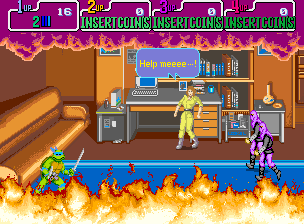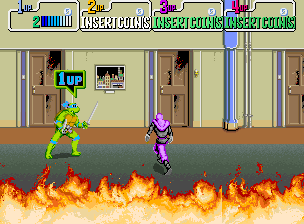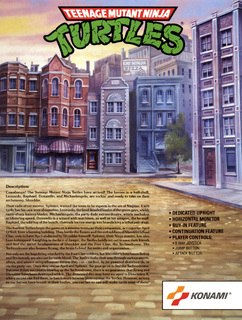Teenage Mutant Ninja Turtles II: The Arcade Game for Arcade
ArcadeGame controls in browser
Show Controller & SystemClick on play Arcade game now button first to load the game into the emulator. Before the start do not forget to toss the coin first (key 1) into the machine slot. Arcade controls:
Teenage Mutant Ninja Turtles II: The Arcade Game
Online version of Teenage Mutant Ninja Turtles II: The Arcade Game for Arcade. Teenage Mutant Ninja Turtles is a 1989 arcade game released by Konami and based on the first Teenage Mutant Ninja Turtles animated series that began airing two years earlier. In the game, up to four players control the titular Ninja Turtles, fighting through various levels to defeat the turtles' enemies, including the Shredder, Krang and the Foot Clan. Released during a high point in popularity for the Ninja Turtles franchise, the arcade game was well received and versions for various home systems soon followed, including the NES. The player chooses from one of the four Ninja Turtles: Leonardo, Michelangelo, Donatello, and Raphael...
Game details
Covers - Box Art
Arcade game
Online emulated version of Teenage Mutant Ninja Turtles II: The Arcade Game was originally developed as arcade game or coin-op game,
a coin-operated entertainment machine typically installed in public businesses such as restaurants, bars and amusement arcades. Most arcade games are video games,
pinball machines, electro-mechanical games, redemption games or merchandisers. While exact dates are debated, the golden age of arcade video games is usually defined
as a period beginning sometime in the late 1970s and ending sometime in the mid-1980s.
Virtually all modern arcade games (other than the very traditional Midway-type games at county fairs) make extensive use of solid state electronics,
integrated circuits and cathode-ray tube screens. In the past, coin-operated arcade video games generally used custom per-game hardware often with multiple CPUs,
highly specialized sound and graphics chips, and the latest in expensive computer graphics display technology. This allowed arcade system boards to produce
more complex graphics and sound than what was then possible on video game consoles or personal computers, which is no longer the case in the 2010s.
This emulation is powered by MAME (Multiple Arcade Machine Emulator) project, an open-source emulator designed to recreate the hardware of arcade game systems in software on modern personal computers and other platforms. Its intention is to preserve gaming history by preventing vintage games from being lost or forgotten.

















